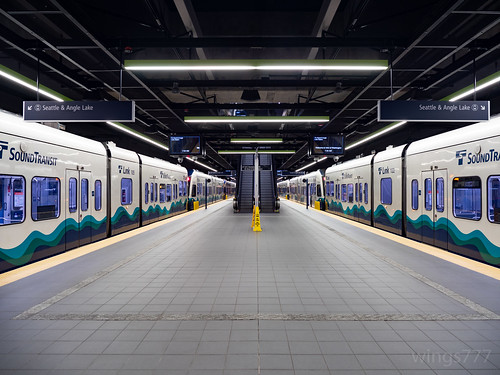A way to restore Link frequency and save money
 UW Station, 8 LRVs, 0 passengers (during Connect 2020) / photo by wings777
UW Station, 8 LRVs, 0 passengers (during Connect 2020) / photo by wings777Link Light Rail has become little more than an exercise in keeping a transit line running during the pandemic. Although it is one of the safest transit options in town due to social distancing, because of dramatically low ridership and the ability to choose different cars, it has nevertheless become nearly useless for getting its passengers somewhere in a decent amount of time. Frequency matters.
An obvious part of the problem is that even while Link ridership has dropped 90%, SeaTac Airport ridership plummeted 95%. The climate activist in me says that is a good problem to have, just not for the reasons I hoped.
Currently, Link runs every 20 minutes each direction during the day on weekdays and every 30 minutes on weekends. If you want to know when to be there to catch it, you have to have a smart phone, have looked up online or printed out or memorized the schedule, or have printed out Alex's table. The schedules showing at the stations are what would have been if not for COVID-19.
Sound Transit has published its preliminary planned schedule (or at least weekday frequencies) for the service change that takes effect and runs from September 19, 2020 to March 19, 2021. Link is slated to run every 8 minutes during peak, every 15 minutes mid-day, and every 30 minutes in the evening. Planned weekend infrequency has not yet been published.
Link has been running full-length 4-car trains since the beginning of the Connect2020 construction slow-down in January. The epidemic was declared just in time to avoid a temporary restoration of 10-minute off-peak and 6-minute peak headway. For those of us looking forward to the old normal, it has been a long wait.
Now, King County Metro, which provides the operators for Link, has laid off 200 part-time operators. This comes as somewhat of a surprise since the Link schedule reductions were in part due to lack of operator availability. This seems as good a time as any to rethink the principles driving Link's schedule, since there are ample operators available now, and we want to keep them employed.
So, let's start with some assumptions:
- There are enough operators available to staff whatever Link schedule Sound Transit wants to use (as evidenced by the layoff).
- Capacity on the trains is well beyond what is necessary for passenger safety (which is nonetheless threatened by the presence of a few riders not wearing their masks properly \_()_/).
- Sound Transit wants to minimize the cost of operating Link during the pandemic.
- The hourly cost of an operator is more than the hourly cost of running a light rail vehicle (LRV), but less than the cost of running two LRVs.
To keep the math simple, I will be using the viewpoint of a passenger at a station.
On weekdays, three operators and 12 LRVs (three 4-car trains) pass by in each direction most hours. What would it look like if Sound Transit were to instead run 2-car trains, and run them more often? By adding an operator per hour per direction (from the station view, that is), headway could be reduced to 15 minutes, and only 8 LRVs would be necessary. That would be a substantial savings for ST and a noticeable service improvement.
But consider how far ST could go, while still saving money, with 1-car consists. ST could run 6 consists per hour per direction (from the station view), restoring the old normal of 10-minute off-peak headway. For every operator added, two LRVs would be removed from the current fleet schedule. That should save ST a good chunk of change, even before accounting for improved ticket and pass sales.
On weekends, 2-car trains would allow restoration of 20-minute headway, with some savings. One-car consists would allow 15-minute headway, with even more savings.
If peak ridership returns (which is more dependent on downtown employees going back to on-site work and somewhat less dependent on UW's planned hybrid teaching plan for the autumn quarter), that will drive the need to have 4-car trains. That presumes there will be a massive abandonment of work-from-home long before the pandemic is over. However, warnings of a seasonal resurgence of the novel coronavirus in October have been coming from various epidemiologists and agencies. In the meantime, we (as a country and a species) have not gotten our collective act together to tamp down the current resurgence before the seasonal one we know is likely to come.
I would be surprised if there is enough of a peak ridership resurgence to justify the planned peak capacity any time before next March. The low peak ridership would leave ST with flexibility to use shorter trains and improve all-day frequency.
Using fewer LRVs extends the life of the fleet. Using more operators leaves Transit in a better position to bounce back when the ridership comes back. I predict that when that happens, Metro will go back into its permanent chase to catch its tail on staffing all the service that it wants to provide. ST would be doing Metro, riders, and itself a favor by investing now in keeping operators working and saving money daily on operational costs and on long-term fleet replacement.
Regardless, if more capacity is needed to make riding Link safe, so be it. From my most recent rides on Link, it really has less to do with spaciousness (of which there is plenty) and more to do with riders not pulling up their masks, all the way over their mouth and nose.